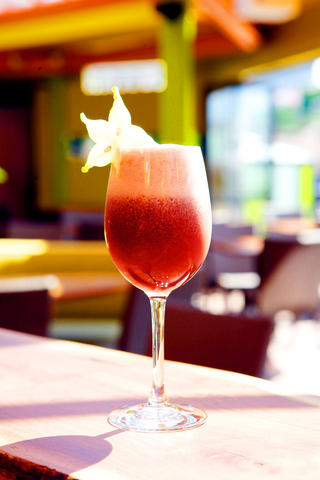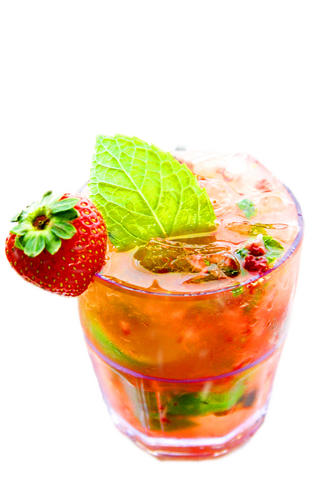On Monday around 9pm, three young Brooklynites stopped into Counter, a vegetarian restaurant in the East Village. Laughing and chatting, they sampled organic raspberries, poached pears, fresh pineapple and strawberries.
That this bounty was found not tableside but at the bar, where the restaurant's menu of organic cocktails has been steadily expanding, only heightened the appeal.
"It's the same thing as top-shelf liquor," said Nick Guffey, 28, a massage therapist with an ink-black shag haircut, referring to drinks like his red-wine-and-poached-pear organic cocktail. "You can drink a tonne and not wake up with a hangover."

PHOTO: NY TIMES NEWS SERVICE
Ellen Pugliese, 24, a publicist friend next to him, agreed. "It's better than drinking soda or something with syrup," she said.
Ayn Teigman, 24, a legal assistant, went further. "I drank my dinner a couple of times. I'm kind of proud of that," she said, rattling off a few of the fresh ingredients she has used, like pomegranate and strawberries. "And muddled cucumber," she added. "That's a vegetable, right?"
In an era of "natural" cigarettes, trans-fat-free chips and low-carb beer, it is probably no surprise that that last guilty pleasure, the cocktail, is trying to atone for its sins. And it isn't just vegan restaurants serving more vitamin-rich vodka mixes and slinging vegetable gardens in a glass.

PHOTO: NY TIMES NEWS SERVICE
Whether absurd or merely inevitable, the idea of healthier tippling has started to catch on among those who have embraced things like organic food and low-sugar diets. Always ready to pounce on a fad, mixologists at trendy bars, restaurants and clubs in New York and Los Angeles have begun creating concoctions from organic fruit and vegetable purees and vitamin-filled sports drinks instead of gooey syrups.
At the same time, a new generation of liquor brands built around herbal extracts and antioxidant-rich ingredients like green tea, pomegranate and the Brazilian acai berry (the current "it" fruit) have hit the market. Sugary cosmopolitans, apple martinis and mojitos have started to look as dated as Sex and the City reruns. A more contemporary alternative would be a drink like Vitamin Dj, mixed from freshly juiced organic carrots, Granny Smith apple juice, elderflower liqueur and vodka, which was introduced a few weeks ago at the Midtown restaurant Django.
Going green
"Everybody seems to be getting healthy," said Mark Murphy, the executive chef at Ditch Plains, a surfer-inspired restaurant in the West Village. Or at least healthier. Murphy recently created a line of cocktails mixing vodka with low-calorie, sugar- and aspartame-free airforce Nutrisoda-brand sodas - each containing a day's dose of vitamins C, E, B6, and B12 - as a more health-conscious variation on the Red Bull and vodka.
The idea that even alcohol could be more beneficent represents a collision of broader trends, said Frank Coleman, a spokesman for the Distilled Spirits Council. As people have become more health literate and corn-syrup-phobic, labels like green and organic have become faddish, and the culinary shift toward farm-fresh, locally grown ingredients has crossed over from kitchen to bar. "All of these epicurean issues are coming together in a martini glass, as it were," Coleman said.
The healthful-cocktail concept received an imprint of credibility in April, when researchers at the US Department of Agriculture, in conjunction with Thai colleagues, reported that adding alcohol to strawberries and blackberries increased their antioxidant capacity (although alcohol still causes some cell damage, some scientists cautioned).
While skeptics could validly point out that trying to mix a Theragran's worth of vitamins into a tumbler of 80 proof makes no more sense than ordering a Diet Coke with a supersize burger and fries, nutritionists do not necessarily scoff at the idea. Wahida Karmally, the director of nutrition at the Irving Institute for Clinical and Translational Research at the Columbia University Medical Center, said that the sugar in a traditional margarita, loaded with syrupy triple sec, "is just empty calories."
"If people are trying to make a syrupy drink," she said, "they might want to puree kiwi fruit, which will give you the syrupy flavor, but also give you nutrients as well as fiber. Kiwi is packed with vitamin C."
The waiters at Sushi Samba, a singles-friendly restaurant and lounge with locations in New York, Miami, Chicago and Tel Aviv, have recently been hawking the health properties of a drink called the Samba Juice, made with the acai berry - a sort of super-grape harvested from the Brazilian rainforest that has more antioxidants than blueberries or cranberries, said Paul Tanguay, the beverage director. "People think it is guilt-free," Tanguey said. "But it still contains alcohol."
The chain sells up to 50 of the US$11 drink per location each night - about a quarter the number of caipirinhas, but the number is steadily growing, he said.
The caterer Serena Bass has introduced a number of new vegetable-based drinks, like one blending yellow-tomato puree with cilantro-infused vodka. "They're popular on the beach," she said. "You don't want to drink some peach-infused thing with a crab cake."
The concept is catching on among young trendsetters, too.
Gemma Hart Corsano, 28, a photo director and event planner, said she often uses fresh fruit purees instead of sugary mixers for cocktails at dinner parties at her Brooklyn home. "It's the same thing as a healthy steak," she added. "Would you rather eat a grass-fed free-range steak, or a hormone-pumped one filled with steroids that lived in a cage its whole life?"
But not all are sold on the idea. David Wondrich, the drinks correspondent for Esquire magazine who said he was recently asked by his editors for the first time to devise a recipe for a healthful cocktail, said such new vegetable-based drinks sound like "they would make for a great soup."
Pleasure without pain?
A cocktail, he said, "should be a reward, not a chore," adding that an ideal cocktail should be a bit naughty. "You don't want it to be straight out of a doctor's office."
It isn't just ingredients that have become more health-focused, but the liquors themselves. A number of "organic" rums, vodkas and gins are now available, and would seem to make for a more healthful cocktail. However, Coleman of the Distilled Spirits Council said the concept of organic spirits was somewhat meaningless, since the distillation process burns off impurities. But that hasn't stopped several companies from trying to appeal to health-conscious consumers by introducing spirits containing pomegranate (witness Pama, a liqueur that blends "all-natural pomegranate juice" with vodka and tequila) and green tea (TyKu, a sake-based liqueur, has popped up in gossip columns in the hands of celebrities like Laurence Fishburne and Kevin Spacey).
In May, two brothers, Courtney and Carter Reum, both former investment bankers, introduced VeeV, a 60-proof acai liqueur that also contains extract of prickly pear, a cactus, which is a faddish folk remedy for a hangover. VeeV-based cocktails, like the Joie de VeeV, made with fresh strawberry, lime, mint and a dash of Splenda, have started popping up at places like the Skybar at the Mondrian Hotel and the Bar Marmont in Los Angeles.
Cocktail purists insist, though, that even the best intentions can't stave off a morning of regrets. Tushan Zaric, an owner and bartender at the downtown lounge Employees Only, said that in the last 18 months he has started hearing patrons diving into drinks like the Ginger Smash, with its fresh cranberries and muddled fresh ginger, saying, "That's so good for you."
"It's the alibi, 'I want to get high with no consequence,'" Zaric said, adding, "But we know, you have two or three of them, you're still going to have the hangover."
WARNING: Excessive consumption of alcohol can damage your health.

May 26 to June 1 When the Qing Dynasty first took control over many parts of Taiwan in 1684, it roughly continued the Kingdom of Tungning’s administrative borders (see below), setting up one prefecture and three counties. The actual area of control covered today’s Chiayi, Tainan and Kaohsiung. The administrative center was in Taiwan Prefecture, in today’s Tainan. But as Han settlement expanded and due to rebellions and other international incidents, the administrative units became more complex. By the time Taiwan became a province of the Qing in 1887, there were three prefectures, eleven counties, three subprefectures and one directly-administered prefecture, with

It’s an enormous dome of colorful glass, something between the Sistine Chapel and a Marc Chagall fresco. And yet, it’s just a subway station. Formosa Boulevard is the heart of Kaohsiung’s mass transit system. In metro terms, it’s modest: the only transfer station in a network with just two lines. But it’s a landmark nonetheless: a civic space that serves as much more than a point of transit. On a hot Sunday, the corridors and vast halls are filled with a market selling everything from second-hand clothes to toys and house decorations. It’s just one of the many events the station hosts,

Among Thailand’s Chinese Nationalist Party (KMT) villages, a certain rivalry exists between Arunothai, the largest of these villages, and Mae Salong, which is currently the most prosperous. Historically, the rivalry stems from a split in KMT military factions in the early 1960s, which divided command and opium territories after Chiang Kai-shek (蔣介石) cut off open support in 1961 due to international pressure (see part two, “The KMT opium lords of the Golden Triangle,” on May 20). But today this rivalry manifests as a different kind of split, with Arunothai leading a pro-China faction and Mae Salong staunchly aligned to Taiwan.

Two moves show Taichung Mayor Lu Shiow-yen (盧秀燕) is gunning for Chinese Nationalist Party (KMT) party chair and the 2028 presidential election. Technically, these are not yet “officially” official, but by the rules of Taiwan politics, she is now on the dance floor. Earlier this month Lu confirmed in an interview in Japan’s Nikkei that she was considering running for KMT chair. This is not new news, but according to reports from her camp she previously was still considering the case for and against running. By choosing a respected, international news outlet, she declared it to the world. While the outside world